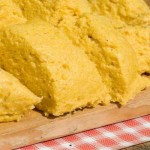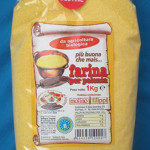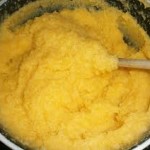Ciao a tutti!
Pasta, bread and traditional risottos are not the only staples you will find in Italy! Especially northern Italy, where polenta, a corn based dish, is a common food in many of the households.
 Polenta is corn meal added with water, salt and some olive oil. Regions where you will commonly find polenta are Lombardy, Piemonte, Veneto and Valle d’ Aosta, where the temperatures are usually a bit cold in winter, hence the heavier food. It is extremely versatile and can be used for the base in several different dishes.
Polenta is corn meal added with water, salt and some olive oil. Regions where you will commonly find polenta are Lombardy, Piemonte, Veneto and Valle d’ Aosta, where the temperatures are usually a bit cold in winter, hence the heavier food. It is extremely versatile and can be used for the base in several different dishes.
Many traditional recipes use polenta along with mushrooms or a meat-based meal, however polenta, as versatile as it is, can also be eaten as a side with rosemary carrots and brown lentils, or home-cooked black beans and tomatoes with basil (as done in many south American places).
 It is economical and very easy to make, however cooking time is around 40-45 minutes so be prepared to do some stirring if you are cooking polenta. Some grocery stores will sell it already made in a tube, so you can just open, heat and serve. Just read the ingredient labels first, since you never know what kind of additives they put in there. You can also use pre-cooked or fast cooking corn meal, which usually cooks in about 10 minutes.
It is economical and very easy to make, however cooking time is around 40-45 minutes so be prepared to do some stirring if you are cooking polenta. Some grocery stores will sell it already made in a tube, so you can just open, heat and serve. Just read the ingredient labels first, since you never know what kind of additives they put in there. You can also use pre-cooked or fast cooking corn meal, which usually cooks in about 10 minutes.
What to watch out for if eating polenta in restaurants or in other peoples’ homes:
- Make sure they have not used animal broth in place of water. Some restaurants will use broth they have left from meat meals to use for polenta or risottos. They may also use the “dado” cubes, which are the bullion cubes used to make broths. The only way to know is to ask how they make the polenta. They may also use store-bought tubes; just depends how authentic the restaurants are.
- Some places will also add milk or butter to the polenta for a creamy effect. Again, you will need to ask.
- Some places add cheese to the top, usually grated parmesan, for added taste. If the recipe on the menu says formaggio make sure to ask for it senza or without.
The basic recipe is:
1 part corn meal
2 parts water
salt
and olive oil can be added when it is finished to give it a creamy texture.
 The polenta is cooked when it starts to “peel” away from the side of the pot. After it is cooked, it is laid onto a wooden cutting board and can rest for about 5 minutes to harden a bit. Then can be cut into portion size pieces. You can also serve it directly from the pot, where it will be a softer consistency. The taste is still the same, though!
The polenta is cooked when it starts to “peel” away from the side of the pot. After it is cooked, it is laid onto a wooden cutting board and can rest for about 5 minutes to harden a bit. Then can be cut into portion size pieces. You can also serve it directly from the pot, where it will be a softer consistency. The taste is still the same, though!
